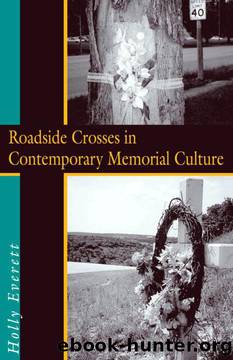Roadside Crosses in Contemporary Memorial Culture by Holly Everett

Author:Holly Everett [Everett, Holly]
Language: eng
Format: epub
Tags: Arts & Photography, Architecture, Buildings, Religious Buildings, Literature & Fiction, Mythology & Folk Tales, Fairy Tales, Folklore, Politics & Social Sciences, Anthropology, Social Sciences, Customs & Traditions, Folklore & Mythology, Sociology, Death, Self-Help, Death & Grief, Grief & Bereavement, Building Types & Styles, Health; Fitness & Dieting
Amazon: B00ETBCPJ0
Publisher: University of North Texas Press
Published: 2002-09-11T04:00:00+00:00
The communicative power that roadside crosses accrue as a result of the tension between private and public, and the recognition of "ordinary" lives and memories, results from contemporary responses to death in North American society. Many scholars and health care practitioners, such as Geoffrey Gorer (1965), Jack Kamerman (1988), Kathy Charmaz (1980), and Phyllis Silverman (1981) have studied such responses in North America and Britain. All note the increasing isolation of bereaved individuals and contributing societal conditions, such as the development, Kamerman writes, of "mechanisms... in American society to keep death out of sight and out of minds," (1988, 2). Similarly, Charmaz refers to the "social construction of the denial of death" (1980, 88-96). Indeed, the contemporary experience of loss, even when documented almost four decades ago by Jessica Mitford in her oft-cited The American Way of Death (1963), frequently involves the medical establishment and the death care industry in processes that minimize contact between the deceased and her or his survivors.
Writing about the Vietnam Veterans Memorial, Hass outlines the way in which many contemporary Americans experience the death of a relative or friend: "The standard funeral... begins with death in a hospital and transportation of the body to a funeral home. There the body is embalmed, dressed, and made up; this process is usually followed by a viewing of the body and a funeral service in the church of the deceased or at the funeral home. The service is most often followed by a smaller burial service at the cemetery" (1998, 76). In nineteenth century America, however, death often took place in the home, as did preparation for burial and visitation by the community. Nearby cemeteries further strengthened the immediacy of death in the sphere of everyday activity (Laderman 1996, 23-37). In the current context of bereavement, the home symbolizes seclusion and detachment from the everyday activity of the public sphere (Rosenblatt, Walsh and Jackson 1976, 46). Roadside crosses and memorial assemblages, by contrast, occupy a space in the public landscape, and imagination, in between the home and the often geographically removed modern cemetery. As revealed by my informants' statements, many aspects of unofficial memorial maintenance are further indicative of their interstitial nature, as their continued existence exhibits a combination of tacit civic support and active community involvement.
The Art of Domestic Experience
Viewed as an extension of domestic activity, corollaries to the roadside cross tradition in Texas are observable in the complex of custom and practice that constitute Day of the Dead celebrations throughout Latin America and the United States.' Folk art historians Elizabeth Carmichael and Chloe Sayer have studied traditional observances across Mexico. They found that women generally cook the majority of the food items placed on altars and left at the cemeteries. In those families who own bread ovens, the men of the household do the baking after the women have mixed the dough (1991, 18, 78). Freddy Mendez, a resident of La Congregacion del Tajin in the state of Veracruz, for example, describes the way in which
Download
This site does not store any files on its server. We only index and link to content provided by other sites. Please contact the content providers to delete copyright contents if any and email us, we'll remove relevant links or contents immediately.
Kathy Andrews Collection by Kathy Andrews(11705)
The remains of the day by Kazuo Ishiguro(8785)
Paper Towns by Green John(5061)
Spare by Prince Harry The Duke of Sussex(5052)
The Body: A Guide for Occupants by Bill Bryson(4945)
Industrial Automation from Scratch: A hands-on guide to using sensors, actuators, PLCs, HMIs, and SCADA to automate industrial processes by Olushola Akande(4907)
Machine Learning at Scale with H2O by Gregory Keys | David Whiting(4094)
Be in a Treehouse by Pete Nelson(3922)
Never by Ken Follett(3758)
Harry Potter and the Goblet Of Fire by J.K. Rowling(3758)
Goodbye Paradise(3708)
Into Thin Air by Jon Krakauer(3287)
The Remains of the Day by Kazuo Ishiguro(3278)
The Cellar by Natasha Preston(3241)
The Genius of Japanese Carpentry by Azby Brown(3208)
Fairy Tale by Stephen King(3192)
120 Days of Sodom by Marquis de Sade(3159)
The Man Who Died Twice by Richard Osman(2977)
Drawing Shortcuts: Developing Quick Drawing Skills Using Today's Technology by Leggitt Jim(2974)
